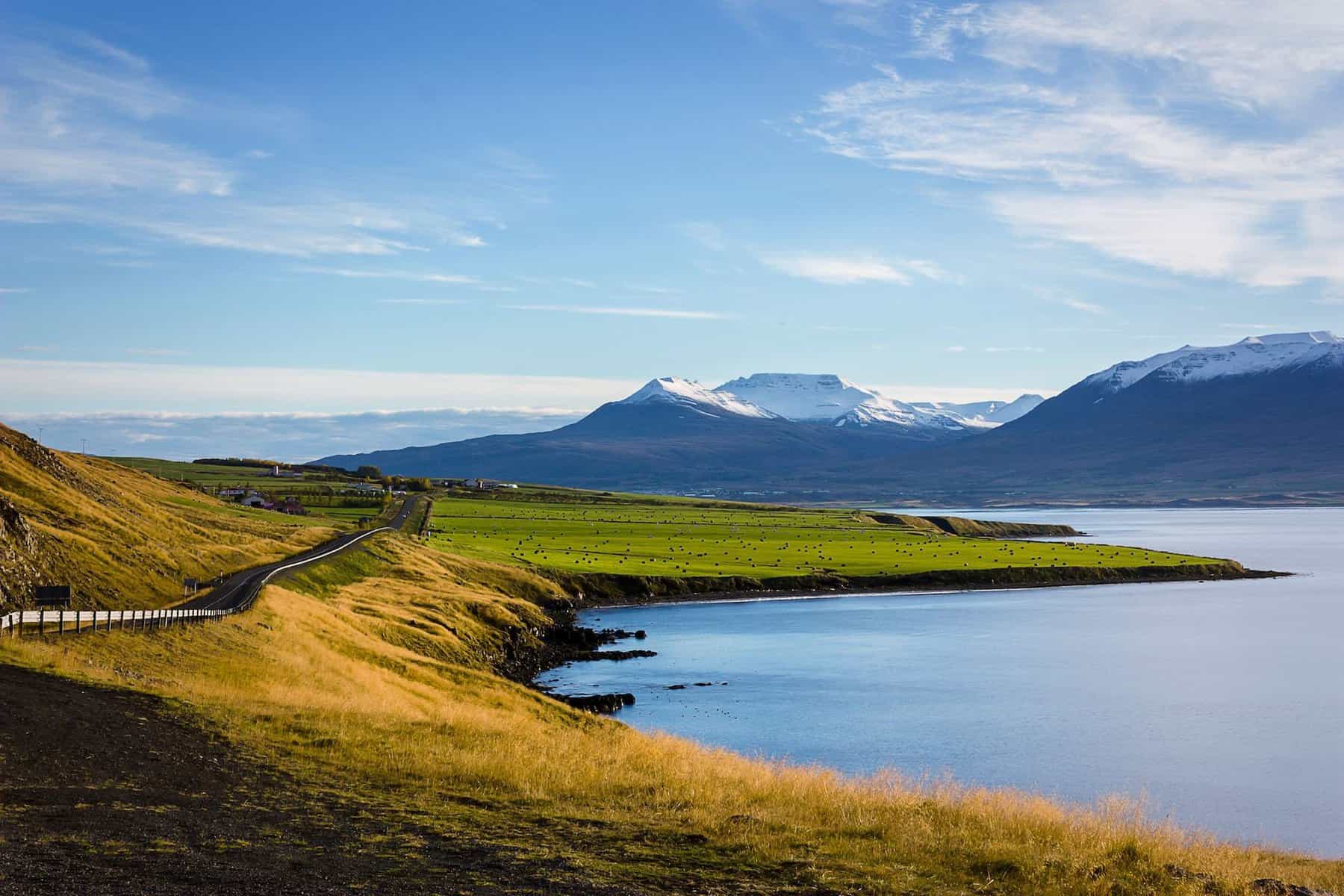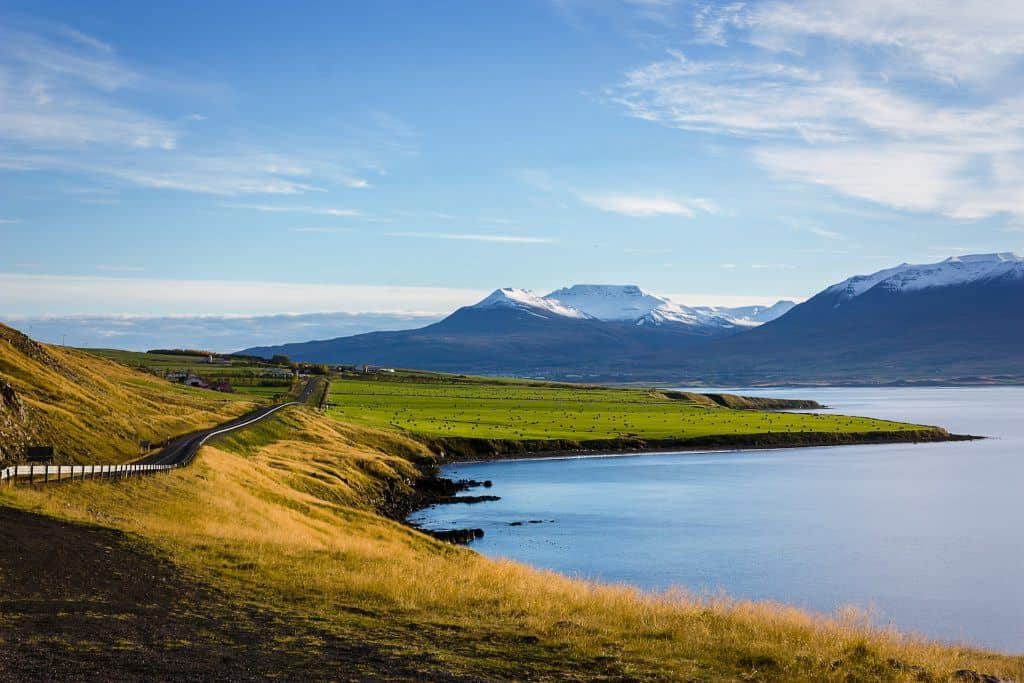11 MFAQ Questions About Visiting Iceland
Yes, MFAQ. That stands for Most Frequently Asked Questions, and is not some kind of naughty euphamism. Onward!

1. What is the best time to visit Iceland?
If you’re looking for the best time to visit Iceland, it really depends on what you want to experience. Here’s a breakdown of the different seasons and what they offer:
- Summer (June – August): This is the peak tourist season in Iceland, with long days and mild temperatures. It’s the perfect time for hiking, camping, and exploring the stunning landscapes. However, be prepared for higher prices and larger crowds.
- Winter (December – February): If you want to witness the magical Northern Lights, this is the time to visit. The winter months offer shorter days, colder temperatures, and the possibility of snowstorms. But don’t worry, you can still enjoy activities like ice cave tours and glacier hikes.
- Shoulder Seasons (April – May, September – October): These months offer a balance between the two extremes. You can enjoy milder weather, fewer tourists, and the chance to see the Northern Lights in the early spring or late autumn.
Ultimately, the best time to visit Iceland depends on your preferences and what you want to experience. Just remember to pack appropriate clothing for the weather and plan your activities accordingly.
2. How many days do I need to explore Iceland?
To truly experience the beauty of Iceland, it’s recommended to spend at least 7-10 days on the island. This will give you enough time to explore the popular attractions along the Ring Road, such as the Golden Circle, the South Coast, and the Diamond Beach.
However, if you have limited time, you can still have a memorable trip in Iceland. Here’s a breakdown of how many days you might need for different itineraries:
- 3-4 days: With a short trip, you can explore Reykjavik, visit the Blue Lagoon, and take a day tour to the Golden Circle.
- 5-6 days: This allows you to add the South Coast and the Jökulsárlón Glacier Lagoon to your itinerary, giving you a taste of Iceland’s diverse landscapes.
- 7-10 days: With a week or more, you can venture further east or north, exploring places like the Snæfellsnes Peninsula, the Westfjords, or the Lake Mývatn area.
Remember, Iceland is a country of vast natural beauty, so the more time you have, the more you can explore and immerse yourself in its wonders.
3. Do I need a visa to visit Iceland?
If you’re a citizen of the European Union (EU) or the Schengen Area, you do not need a visa to visit Iceland. You can stay for up to 90 days within a 180-day period without a visa.
For citizens of other countries, it’s essential to check the visa requirements before your trip. Iceland is a member of the Schengen Area, so if you have a valid Schengen visa, you can also enter Iceland.
Make sure to check the official website of the Icelandic Directorate of Immigration for the most up-to-date information on visa requirements.
4. What is the currency in Iceland?
The currency in Iceland is the Icelandic Króna (ISK). While credit cards are widely accepted in most places, it’s always a good idea to carry some cash for smaller establishments or remote areas where card payments may not be available.
You can exchange your currency for Icelandic Króna at banks, currency exchange offices, or at the airport upon arrival. It’s advisable to have some cash on hand for things like public transportation, small purchases, or tips.
5. Is it safe to drink tap water in Iceland?
Yes, it is perfectly safe to drink tap water in Iceland. In fact, Icelandic tap water is known for its exceptional quality and purity. You can fill up your water bottle from any tap or stream without any concerns.
Icelandic tap water comes from natural springs and glaciers, and it undergoes minimal treatment before reaching your faucet. It is not only safe to drink but also delicious and refreshing.
So, save some money and help the environment by refilling your water bottle with the pure Icelandic tap water wherever you go.
6. What should I pack for a trip to Iceland?
Packing for Iceland requires some careful consideration due to the country’s unpredictable weather and diverse landscapes. Here are some essential items to pack for your trip:
- Layers of clothing: Iceland’s weather can change rapidly, so it’s important to dress in layers. Pack thermal base layers, a warm fleece or sweater, a waterproof and windproof jacket, and a good pair of waterproof hiking boots.
- Rain gear: A sturdy rain jacket and waterproof pants are essential to keep you dry during unexpected rain showers or while exploring waterfalls and glaciers.
- Swimsuit and towel: Don’t forget to pack your swimsuit and a towel for a relaxing dip in the geothermal pools or a visit to the famous Blue Lagoon.
- Travel adapter: Iceland uses the Europlug (Type C/F) electrical outlets, so make sure to bring a travel adapter if your devices have a different plug type.
- Camera and extra batteries: Iceland’s landscapes are incredibly photogenic, so don’t forget to bring your camera and extra batteries to capture those breathtaking moments.
Remember to pack according to the season you’re visiting and check the weather forecast before your trip to ensure you’re prepared for the conditions.
7. Can I see the Northern Lights in Iceland?
Yes, Iceland is one of the best places in the world to witness the mesmerizing Northern Lights, also known as the Aurora Borealis. However, seeing the Northern Lights depends on several factors:
- Time of year: The best time to see the Northern Lights in Iceland is during the winter months (September to April) when the nights are longer and darker.
- Weather conditions: Clear skies are essential for optimal Northern Lights viewing. Cloudy or overcast skies can obstruct the visibility of the auroras.
- Location: Getting away from city lights and light pollution increases your chances of seeing the Northern Lights. Head to remote areas or book a tour to the countryside for the best viewing opportunities.
Remember, the Northern Lights are a natural phenomenon, and their appearance can never be guaranteed. Patience and a bit of luck are key when chasing the auroras.
8. Can I drive in Iceland with my foreign driver’s license?
Yes, you can drive in Iceland with a valid foreign driver’s license. If your license is written in English or another Latin alphabet, you do not need an International Driving Permit (IDP). However, if your license is in a non-Latin alphabet, it’s recommended to carry an IDP along with your license.
It’s important to note that driving in Iceland can be challenging, especially during winter. The weather conditions, narrow roads, and unpredictable terrain require caution and experience. If you’re not confident in your driving skills or unfamiliar with driving in such conditions, it’s advisable to join guided tours or hire a local driver.
9. Are there mosquitoes in Iceland?
One of the great things about Iceland is its lack of mosquitoes! Due to the country’s cold climate and windy conditions, mosquitoes are not a significant issue in most parts of Iceland. You can enjoy outdoor activities without the annoyance of these pesky insects.
However, it’s always a good idea to bring some insect repellent, especially if you plan to visit the Westfjords or other areas where mosquitoes might be present during the summer months.
10. Can I visit the Blue Lagoon in winter?
Yes, you can visit the Blue Lagoon in winter, and it’s a magical experience. The geothermal spa’s warm, milky-blue waters surrounded by snow-covered lava fields create a stunning contrast.
Here are a few tips for visiting the Blue Lagoon in winter:
- Book in advance: The Blue Lagoon is a popular attraction, so it’s recommended to book your tickets in advance to secure your preferred time slot.
- Dress warmly: While the water in the lagoon is warm, the air temperature can be chilly, especially during winter. Dress in warm layers and bring a hat and gloves for when you’re outside the water.
- Enjoy the amenities: The Blue Lagoon offers various amenities, including saunas, steam rooms, and a relaxation area. Take advantage of these facilities to warm up and unwind.
- Capture the moment: Don’t forget to bring your camera or smartphone to capture the beautiful winter scenery and your rejuvenating experience at the Blue Lagoon.
Visiting the Blue Lagoon in winter is a unique and unforgettable experience that shouldn’t be missed.
11. What are some must-visit attractions in Iceland?
Iceland is a land of natural wonders, and there are countless must-visit attractions that will leave you in awe. Here are some of the top attractions you shouldn’t miss:
- The Golden Circle: This popular tourist route includes three iconic sites: Þingvellir National Park, where you can walk between two tectonic plates; the powerful Gullfoss waterfall; and the geothermal area of Geysir, home to the famous Strokkur geyser.
- The South Coast: Explore the stunning black sand beaches, such as Reynisfjara and Dyrhólaey, with their dramatic rock formations and basalt columns. Don’t miss the majestic Skógafoss and Seljalandsfoss waterfalls along the way.
- Jökulsárlón Glacier Lagoon: Witness the breathtaking sight of icebergs floating in a glacial lagoon. Take a boat tour to get up close to the icebergs and watch them drift towards the nearby Diamond Beach.
- Snæfellsnes Peninsula: Known as “Iceland in Miniature,” this peninsula offers diverse landscapes, including volcanic craters, lava fields, black sand beaches, and the iconic Snæfellsjökull volcano.
- The Blue Lagoon: Relax and rejuvenate in the geothermal waters of the Blue Lagoon. This world-famous spa is known for its milky-blue waters and luxurious amenities.
- Landmannalaugar: Explore the colorful rhyolite mountains, natural hot springs, and stunning hiking trails in this remote highland area. It’s a paradise for nature lovers and outdoor enthusiasts.
- Dettifoss Waterfall: Located in the Vatnajökull National Park, Dettifoss is Europe’s most powerful waterfall. Feel the raw power of the cascading water as it plunges into the Jökulsárgljúfur canyon.
- The Westfjords: Discover the remote and rugged beauty of the Westfjords, with its dramatic fjords, towering cliffs, and picturesque fishing villages. It’s a paradise for birdwatching and outdoor adventures.
- Lake Mývatn: Explore the unique volcanic landscapes surrounding Lake Mývatn, including the otherworldly Dimmuborgir lava formations and the geothermal area of Námaskarð.
- Reykjavik: Don’t forget to spend some time exploring Iceland’s vibrant capital city. Visit the iconic Hallgrímskirkja church, stroll along the colorful streets of the old town, and indulge in delicious Icelandic cuisine.
These are just a few of the many incredible attractions that Iceland has to offer. Each one is unique and will leave you with unforgettable memories of this extraordinary country.
In conclusion, Iceland is a destination that offers something for everyone. Whether you’re seeking adventure, relaxation, or a chance to connect with nature, Iceland has it all. From the stunning landscapes and natural wonders to the vibrant culture and friendly locals, a trip to Iceland is sure to be an unforgettable experience. So pack your bags, embrace the unpredictable weather, and get ready to explore the land of fire and ice.

What a fantastic post about visiting Iceland. You have written a very detailed and informative article that answers all the questions I had about this destination. You also provided some valuable insights and recommendations on how to make the most of my time in Iceland. I liked how you explained the pros and cons of each season, the different types of accommodation, and the must-see attractions. Your post has been very helpful for me.